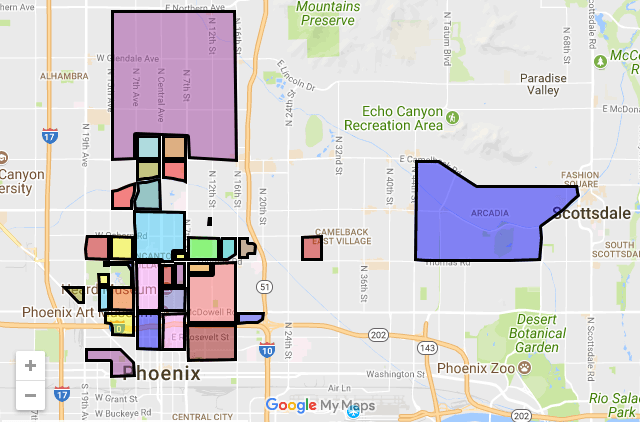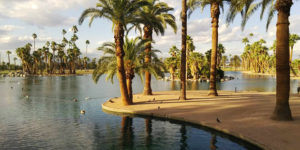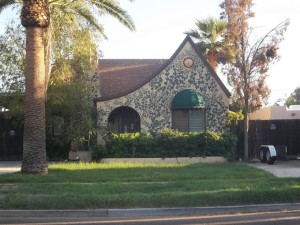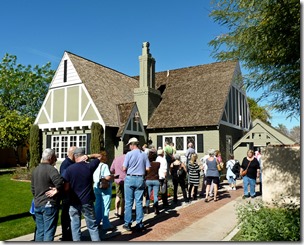A Look at all of the Architectural Styles In Phoenix, Arizona
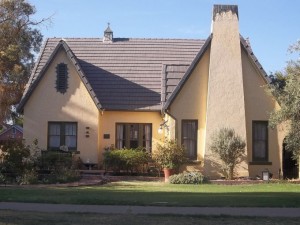
A 1930 Tudor In FQ Story Historic District
Historic homes in Phoenix’ districts don’t only have an incredible history’s with telling pasts, but they also embrace an incredibly wide variety of architectural styles. Below is a breakdown of different styles, their history and photos.
Adobe – Pueblo Revival Architecture in Phoenix, Arizona (1908-present)
Because they are built with adobe, Pueblo homes are sometimes called Adobes. Pueblo Revival houses became popular in the early 1900’s, mainly in Arizona, California and New Mexico and inspired by the Pueblo Indians.
Art Moderne and Art Deco (1925-1950’s)
A mix of smooth swirls, curves and high-gloss finishes, art deco style evokes 1930’s movie star glamour. The style was partially inspired by artifacts discovered in 1922 in King Tut’s tomb, and many art deco buildings include the repeating designs and vivid color common in Egyptian artwork.
Bungalow Architecture in Phoenix, Arizona (1880-1930)
The bungalow showed up in America in the 1880’s but it was its development in Southern California that paved the way for its new role as a year-round house which turned it into the most popular house style American had ever known.
Cape Cod Architecture in Phoenix, Arizona (1931-1950)
The first Cape Cod style homes were built by English colonists who came to America in the late 17th century but after World War II, the architect Royal Barry Wills promoted the Cape Cod style for small homes in suburban developments throughout the USA.
French Provincial Architecture in Phoenix, Arizona (1914-1945)
Inspired by estates of the French countryside of the 1600’s, the provincial style came to America after World War I, bringing with it decorative appeal and romantic touches.
Mission Revivals Spanish Architecture in Phoenix, Arizona (1890-1935)
The Mission Revival movement enjoyed its greatest popularity between 1890 and 1915 but continued evolving into the 1930’s. The Spanish Mission Style and its associated Spanish Colonial Revival Style became internationally influential.
Monterey Architecture in Phoenix, Arizona (1920-1960)
The Monterey Style was born in 19th century California, but its popularity expanded throughout a growing 20th century United States.
Ranch Architecture, Old and Modern Style Architecture in Phoenix, Arizona (1930-1985)
Low-slung ranch homes, modeled after the casual style of homes on true Western ranches were first built in the 1930’s and spent the next four decades popping up everywhere throughout the country. Phoenix has an abundance of ranch homes in many flavors from historic to modern.
Spanish Colonial Architecture in Phoenix, Arizona (1890-1930)
Settlers from the Mediterranean fused design from Europe and Native America with their own to create a variety of home styles. Spanish Colonial Revival is used to describe homes built in the early 20th century that incorporate various elements of Mediterranean architecture. But as with all true styles, these homes are linked by a set of common physical characteristics.
Tudor Revival Architecture in Phoenix, Arizona (1890-1950)
Originating in England, the Tudor style is one of the most recognizable home styles. Best known for steeply pitched, multi-gabled roofs and decorative half-timber framing, Tudors were mostly built in established neighborhoods during the first half of the 20th century.
Victorian Architecture In Phoenix, Arizona (1830-1910)
Victorian architecture emerged between 1830 and 1910 under the reign of Queen Victoria and include sub-styles such as Gothic revival, Italianate, Second Empire, Queen Anne, stick style, Romanesque style and shingle style. Constructed more for beauty than functionality, Victorian homes tend to be more complex in design with ornate trim, bright colors, large porches, asymmetrical shape and multi-faceted roof-lines. Victorian-era homes in eastern American cities tend to be three stories and those in western American cities tend to be two-story houses or one-story cottages.
 Turnkey homes in Phoenix – Most people think it simply means that the home is ready for move-in and it’s so nicely remodeled that you don’t have to do anything but move in and enjoy! Now, this is definitely true, but here’s the REAL definition, although similar, but more accurate.
Turnkey homes in Phoenix – Most people think it simply means that the home is ready for move-in and it’s so nicely remodeled that you don’t have to do anything but move in and enjoy! Now, this is definitely true, but here’s the REAL definition, although similar, but more accurate.